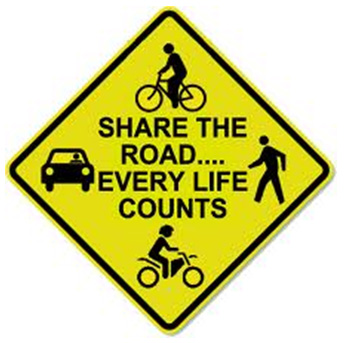
- Be alert and use extra care when sharing the road with pedestrians, bicycles, motorcycles and other vehicles. Some vehicles are small and hard to see. Also be extra aware when children are present because their movements can be unpredictable.
- Watch for commercial vehicles that make frequent stops. Allow more following distance.
- Check your vehicle mirrors and look over your shoulder for approaching traffic when pulling into traffic from curbside parking or driveways.
- Be alert, listen and watch for road and traffic signs when driving in the roadway.
Sharing the Road with Pedestrians
As a driver, watch out and always yield the right-of-way to people walking, jogging, biking, crossing the street and especially for pedestrians darting from between parked vehicles.
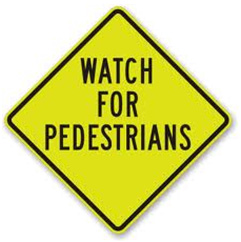
- Watch for them when entering a street from a driveway or alley, at stop signs, traffic signals, roundabouts, crosswalks and intersections.
- Take extra care when people with disabilities are crossing the road.
- Be on high alert for children entering the street when you are driving near schools, playgrounds or residential neighborhoods.
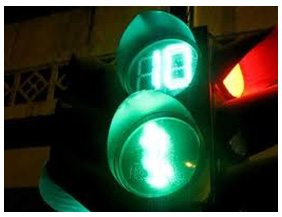 After a traffic light turns green, yield to people crossing the street and for vehicles that may still be turning in front of you or crossing the intersection. Even when traffic lights or crosswalks are not present, drivers must still yield the right-of-way to a pedestrian crossing the roadway. Never attempt to pass any vehicle that has stopped to allow a pedestrian to cross.
After a traffic light turns green, yield to people crossing the street and for vehicles that may still be turning in front of you or crossing the intersection. Even when traffic lights or crosswalks are not present, drivers must still yield the right-of-way to a pedestrian crossing the roadway. Never attempt to pass any vehicle that has stopped to allow a pedestrian to cross.
- Drivers must take every possible precaution to avoid a collision with pedestrians.
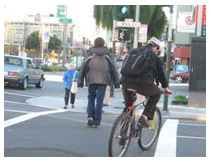 Motorists should be aware that pedestrians are likely to cross in the middle of the block,whether or not a crosswalk is present. Mid-block crosswalks provide pedestrians with safe crossing along roadways at places other than intersections. A yield line is sometimes used to indicate the location where drivers should stop for pedestrians in the crosswalk.
Motorists should be aware that pedestrians are likely to cross in the middle of the block,whether or not a crosswalk is present. Mid-block crosswalks provide pedestrians with safe crossing along roadways at places other than intersections. A yield line is sometimes used to indicate the location where drivers should stop for pedestrians in the crosswalk.- When there are no sidewalks, pedestrians should walk on the side of the road facing oncoming traffic. Parents should teach their children this practice. However, drivers must watch for pedestrians.
- Drivers must be alert for joggers running along roadways. Joggers should wear reflective clothing, use sidewalks or roadways shoulders and avoid jogging at night, dawn, dusk or during bad weather. Joggers, like other pedestrians, should be on the side of the road facing oncoming traffic.
Sharing the Road with Emergency Vehicles
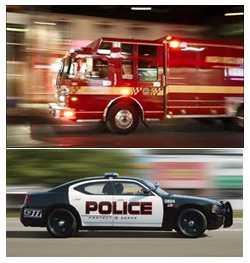 Yield the right-of-way to an emergency vehicle that is displaying flashing warning lights, sounding a siren or any
Yield the right-of-way to an emergency vehicle that is displaying flashing warning lights, sounding a siren or any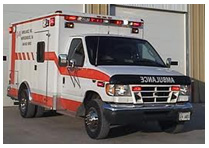 other audible warning sounds that are approaching from any direction of the roadway. These emergency vehicles can be ambulances, fire department and police vehicles.
other audible warning sounds that are approaching from any direction of the roadway. These emergency vehicles can be ambulances, fire department and police vehicles.
When you see a stopped emergency vehicle:
- Slow down and move over a lane if possible.
- If traffic or other conditions prevent you from changing lanes, you must slow down and proceed with due caution.
When an emergency vehicle is approaching:
- Pull over to the edge of the roadway, clear of intersections and stop.
- Remain there until the emergency vehicle has passed.
- Keep your foot on the brake so the brake lights let emergency vehicle drivers know you have stopped.
- Stay at least 500 feet behind any moving emergency vehicle displaying flashing warning lights and/or sounding a siren.
- Never pass a moving emergency vehicle displaying flashing warning lights unless directed to do so by the emergency vehicle driver or a law enforcement officer.
Sharing the Road with Commercial Vehicles
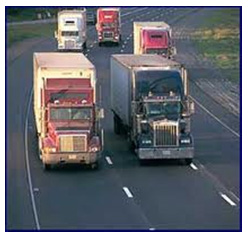 When a commercial vehicle such as a truck or a bus collides with smaller vehicles, people in the smaller vehicles are much more likely to be severely injured or killed.
When a commercial vehicle such as a truck or a bus collides with smaller vehicles, people in the smaller vehicles are much more likely to be severely injured or killed.
- Motorists should understand the following about commercial vehicles:
- Commercial vehicle drivers cannot stop or maneuver their vehicles as easily as a passenger vehicle. They take longer to stop. A passenger vehicle traveling at 55 mph can stop in about 130 feet to 140 feet. A commercial vehicle traveling at the same speed takes 400 feet to stop.
- Although trucks are equipped with up to eight mirrors, it is still easy for a car to be in their blind spot. When following a truck you should keep a safe distance behind the vehicle. If you cannot see the truck’s mirrors, the truck driver cannot see you.

- Commercial vehicles need room to make right turns. They may swing wide to the left to safely negotiate a right turn. When you see a commercial vehicle with its right turn signal on at an intersection, know that the truck is going to make a wide right turn. Do not try to pass on the right-hand side or you might get squeezed between the truck and the curb. Stay behind trucks making right turns.
- Commercial vehicle drivers may not be able to see vehicles alongside or close behind their commercial vehicles. Commercial vehicles have deep blind spots behind them and on both sides. Stay out of their blind spots.
Vehicle size and weight do not cause crashes – drivers do.
Remember to:
- Keep a safe distance behind a truck or bus. Following a commercial vehicle too closely greatly increases the chances of a rear-end collision. When your passenger vehicle is right behind a commercial vehicle, it will severely limit what you can see on the road ahead. Note: Extend the distance between your vehicle and a commercial vehicle as weather or road conditions deteriorate.
- The longer you drive in the blind spots of commercial vehicles, the greater the chances for a crash. A good rule of thumb is if you cannot see the commercial vehicle driver in the truck’s side mirror then the driver cannot see you.
- When following a commercial vehicle, observe its turn signals before trying to pass. Cutting in between a commercial vehicle and the curb or shoulder to the right may result in a crash. If the commercial vehicle appears to be starting a left turn, wait and verify which way the driver is signaling before passing on the right.
- Signal intended lane changes or turns well in advance. Never cut off a truck or bus and force it to slow down or stop suddenly.
- Avoid passing or driving adjacent to larger vehicles in a roundabout.
- Always pass commercial vehicles legally on the left side and maintain a consistent speed when passing. Be sure you can see the entire cab of the truck in your rear-view mirror before signaling and pulling in front of the commercial vehicle.
- Never cross behind a commercial vehicle that is preparing to back up or is backing up. Remember, most trailers are eight and a half feet wide and can hide a car completely, preventing the truck driver from even seeing your vehicle.
- Always stay behind white stopping lines. White stopping lines are there for a reason. If you stop past the line, commercial vehicles will not be able to complete their turns without hitting you.
- When merging onto the freeway, commercial vehicles may not be able to move over, so match the flow of traffic as closely as possible, pick your spot and proceed.
- When exiting the freeway, leave space between you and the vehicle behind you. Plan your move early and always signal your intentions as soon as possible.
- When exiting the freeway, leave space between you and the vehicle behind you. Plan your move early and always signal your intentions as soon as possible.
- At night, use low beam headlights when following a truck or bus.
Sharing the Road with Motorcycles
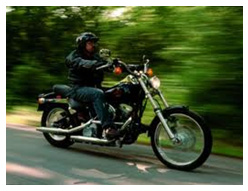
- Always treat motorcycle operators with courtesy. Leave plenty of extra space between your vehicle and a motorcycle ahead. Motorcycles may suddenly swerve to avoid obstacles.
- When pulling out of a side street, remember that an oncoming motorcycle is probably much closer and coming much faster than it appears.
- Pass as you would another vehicle, but not so fast or so close that your tires throw dirt or stones into the rider’s face.
- Before changing lanes, check to see if a motorcycle is in the space where you plan to move. After you pass, look again before you move back into the other lane.
- Many motorcycle-vehicle crashes happen when drivers fail to check their blind spots before turning, changing lanes, backing up or parking.
- When at intersections, watch for oncoming motorcycles and other small vehicles. Their smaller size makes it difficult to judge their distance and speed. Always exercise caution at intersections and allow motorcycles or other small vehicles to clear the intersection before beginning your turn.
- The single headlight or taillight of a motorcycle can blend into the lights of other vehicles. A single light in traffic may mean a motorcycle.
- When making left turns, be alert for possible oncoming motorcycles.
- Watch for clues such as motorcycle operators or passengers turning their heads to look behind or motorcycle operators beginning to lean or tilt their vehicles.
- When coming up behind a motorcycle, slow down sooner than you would for other vehicles. Leave plenty of space.
Sharing the Road with Bicycles
 Bicycling is a form of transportation that many people choose to use for both economic and health benefits. Respect their right-of-way and share the road with bicyclists. Both bicyclists and drivers need to share the responsibility for avoiding conflicts and collisions by communicating their intentions while using the road.
Bicycling is a form of transportation that many people choose to use for both economic and health benefits. Respect their right-of-way and share the road with bicyclists. Both bicyclists and drivers need to share the responsibility for avoiding conflicts and collisions by communicating their intentions while using the road.

